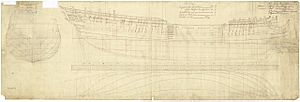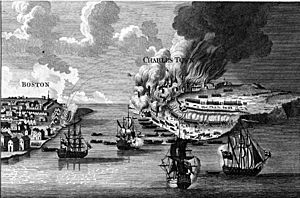HMS Lively (1756) facts for kids

A plan of the Lively
|
|
Quick facts for kids History |
|
|---|---|
| Name | HMS Lively |
| Ordered | 20 May 1755 |
| Builder | Moody Janverin, Bursledon, Hampshire |
| Laid down | c. June 1755 |
| Launched | 10 August 1756 |
| Commissioned | August 1756 |
| Decommissioned | August 1781 |
| Captured | 10 July 1778 |
| Acquired | 10 July 1778 |
| Captured | 29 July 1781 |
| Acquired | 29 July 1781 |
| Fate | Sold 11 March 1784 |
| General characteristics | |
| Tons burthen | 43864⁄94 (bm) |
| Length |
|
| Beam | 30 ft 5+1⁄4 in (9.3 m) |
| Depth of hold | 9 ft 8 in (2.9 m) |
| Complement | 160 officers and men |
| Armament |
|
HMS Lively was a British warship launched in 1756. It was a 20-gun post ship, meaning it was a smaller warship that could be commanded by a captain. During the Seven Years' War, she captured several enemy ships, including the French corvette Valeur. Later, she took part in the American Revolutionary War, even helping to start the famous Battle of Bunker Hill. The French Navy captured her in 1778, but the British took her back in 1781. She was eventually sold in 1784.
Contents
HMS Lively in the Seven Years' War
Lively began its service in July 1756 under Captain Francis Wyatt. In November 1756, it captured a French privateer ship called Intrépide. This ship was from Nantes and had eight guns and 75 crew members. Lively also recaptured a merchant ship named Charming Molly and another called Pike.
In early 1757, Lively sailed to Jamaica. By March 1759, Captain Frederick Maitland was in command.
Intercepting French Ships
On 17 October 1760, Lively was sailing with two other British warships, Hampshire and Boreas. They found five French ships in the Windward Passage. These French ships were carrying sugar and indigo from Cape Francois.
The next day, Lively caught up with the French 20-gun corvette Valeur. After an hour and a half of fighting, Valeur surrendered. Lively had two crew members killed, but Valeur suffered 38 killed and 25 wounded. At the same time, Boreas captured another French ship, Sirenne. Hampshire chased a merchant frigate named Prince Edward onto the shore, where its crew set it on fire.
On 19 October, Hampshire, with Lively and the captured Valeur, trapped the French frigate Fleur de Lis. Its crew also set it on fire to prevent capture.
Changes in Command
In March 1762, Captain J. Jorer took command of Lively. Later that year, Captain Keith Stewart became the commander and sailed the ship in British waters. In June 1763, he took Lively to the Mediterranean Sea.
In April 1769, Captain Robert Fanshawe recommissioned Lively for service in the English Channel. He commanded her until 1771, when Captain G. Talbot took over. In early 1771, Lively served as the flagship for Admiral Richard Spry in Plymouth. On 18 June 1771, Talbot sailed her to North America.
In 1773, Captain William Peere Williams took command and sailed Lively back to Britain. Captain Thomas Bishop recommissioned her in January 1774 and sailed her to North America on 16 April.
HMS Lively in the American Revolutionary War

On 13 May 1774, Lively arrived in Boston, bringing General Thomas Gage. He was appointed governor of the Province of Massachusetts Bay. Lively became part of the British fleet that blocked the port of Boston. This blockade was to enforce the Boston Port Act, a punishment for the Boston Tea Party.
On 22 March 1775, Lively seized a schooner near Cape Ann for breaking trade laws. After the American Revolutionary War began in April 1775, Lively remained in Boston during the Siege of Boston. On 6 May 1775, she seized $23,000 from a ship that had rescued money from a Spanish ship.
Lively was the first ship to fire at the American colonial militia's fortifications. This action helped to start the Battle of Bunker Hill.
Captures and Escorts
In 1776, Lively patrolled off Marblehead. She captured several ships near Cape Ann. These included the schooner Tartar in February and an unknown sloop in May. On 26 June, Lively, Milford, and Hope captured the schooner Lydia.
Lively also escorted the supply ship Levant to various locations, including New York and St. Augustine.
Capture and Recapture of HMS Lively
In March 1777, Captain Robert Biggs recommissioned Lively. On 10 July 1778, Lively was sailing to meet Admiral Keppel's fleet. As the fog cleared, she found herself near the French fleet.
A French cutter, Curieuse, chased Lively and ordered her to stop. Captain Biggs refused. Then, the French frigate Iphigénie approached and ordered Biggs to sail Lively to the French admiral. When Biggs hesitated, Iphigénie fired a broadside, killing 12 British sailors. At that point, Biggs surrendered the ship.
French Service
The French Navy took Lively into their service. In early 1779, she was part of a French squadron that captured Fort St Louis in Senegal from the British.
Lively then sailed to the Caribbean. In June 1779, she led a small group of ships from Martinique to capture the British-controlled island of Saint Vincent.
Recapture by the British
On 29 July 1781, Captain Skeffington Lutwidge's Perseverance recaptured Lively. Lively put up a short, fierce fight, during which six of her crew were killed and ten wounded. Lively was returning from Cayenne and had been at sea for 53 days. She had recently captured two British ships, Rosemount and Katherine. Perseverance recaptured these two ships as well.
By September 1781, Lively was near Sandy Hook with Admiral Robert Digby's squadron. By 14 November, Lively, under Captain Manley, had returned to Britain.
On 3 October 1782, Lively captured the sloop Charles, which was carrying livestock.
Fate of HMS Lively
HMS Lively was sold in March 1784.

